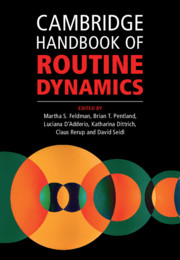Book contents
- Cambridge Handbook of Routine Dynamics
- Cambridge Handbook of Routine Dynamics
- Copyright page
- Contents
- Figures
- Tables
- Contributors
- Preface
- Chapter 1 What Is Routine Dynamics?
- Part I Theoretical Resources for Routine Dynamics Research
- Part II Methodological Issues in Routine Dynamics Research
- Part III Themes in Routine Dynamics Research
- Chapter 15 Truces and Routine Dynamics
- Chapter 16 Context, Embeddedness and Routine Dynamics
- Chapter 17 Routine Interdependence
- Chapter 18 Cognition and Routine Dynamics
- Chapter 19 Time, Temporality and History in Routine Dynamics
- Chapter 20 Replication and Routine Dynamics
- Chapter 21 Innovation Work and Routine Dynamics
- Chapter 22 Design and Routine Dynamics
- Chapter 23 Algorithms and Routine Dynamics
- Chapter 24 Complexity in Routine Dynamics
- Chapter 25 Bodies and Routine Dynamics
- Chapter 26 Emotions and Routine Dynamics
- Chapter 27 Professional Identity and Routine Dynamics
- Chapter 28 Occupations, Professions and Routine Dynamics
- Chapter 29 Routine Dynamics and Management Practice
- Chapter 30 Project-Based Temporary Organizing and Routine Dynamics
- Chapter 31 Self-Managed Forms of Organizing and Routine Dynamics
- Chapter 32 Unexpected Events and Routine Dynamics
- Part IV Related Communities of Thought
- Author Index
- Subject Index
- References
Chapter 16 - Context, Embeddedness and Routine Dynamics
from Part III - Themes in Routine Dynamics Research
Published online by Cambridge University Press: 11 December 2021
- Cambridge Handbook of Routine Dynamics
- Cambridge Handbook of Routine Dynamics
- Copyright page
- Contents
- Figures
- Tables
- Contributors
- Preface
- Chapter 1 What Is Routine Dynamics?
- Part I Theoretical Resources for Routine Dynamics Research
- Part II Methodological Issues in Routine Dynamics Research
- Part III Themes in Routine Dynamics Research
- Chapter 15 Truces and Routine Dynamics
- Chapter 16 Context, Embeddedness and Routine Dynamics
- Chapter 17 Routine Interdependence
- Chapter 18 Cognition and Routine Dynamics
- Chapter 19 Time, Temporality and History in Routine Dynamics
- Chapter 20 Replication and Routine Dynamics
- Chapter 21 Innovation Work and Routine Dynamics
- Chapter 22 Design and Routine Dynamics
- Chapter 23 Algorithms and Routine Dynamics
- Chapter 24 Complexity in Routine Dynamics
- Chapter 25 Bodies and Routine Dynamics
- Chapter 26 Emotions and Routine Dynamics
- Chapter 27 Professional Identity and Routine Dynamics
- Chapter 28 Occupations, Professions and Routine Dynamics
- Chapter 29 Routine Dynamics and Management Practice
- Chapter 30 Project-Based Temporary Organizing and Routine Dynamics
- Chapter 31 Self-Managed Forms of Organizing and Routine Dynamics
- Chapter 32 Unexpected Events and Routine Dynamics
- Part IV Related Communities of Thought
- Author Index
- Subject Index
- References
Summary
In this chapter, we consider the embeddedness of organizational routines within their organizational contexts, drawing on the original work on this construct (Howard-Grenville, 2005), revisiting its core ideas, and reviewing subsequent work that has addressed routine embeddedness. We find that recent work has highlighted the importance of understanding routine dynamics as influenced by and potentially mutually constitutive with other generative aspects of organizational life. We end with calls for future research on this topic and encourage scholars to further explore how routines interact with other core aspects of organizing.
- Type
- Chapter
- Information
- Cambridge Handbook of Routine Dynamics , pp. 229 - 243Publisher: Cambridge University PressPrint publication year: 2021
References
- 2
- Cited by



